FM13, Football manager, Metalist, Player development, re-training players, squad building, training a new fm player, tutoring
Metalist – Player development
In my last Metalist update I touched briefly on the importance we needed to place on the development of players. I choose this sentence carefully, as across the net people talk about player development but they focus mainly on the young players within their squads.
This is logical as there are a number of things we can do to progress young players and create potential stars within our FM worlds. Buying players in their early teens, progressing them to their potential and then moving them on in their mid twenties for vast profits is common place and when applied in cycles can be incredibly successful.
Within this article I am going to explain my approach to player development. Although I do adhere to the above approach of progression for profit, I prefer to think of player development across the life cycle of a player.
A little science
Each player within the game has potential ability (PA) which is the upper limit of their ability and a current ability (CA). The difference between these numbers can be distributed into attribute values. PA and CA are depicted in the game as star values. Players with high PA will have high star ratings. However something that needs to be considered is that star ratings are dynamic and are based on your league and club reputation and the ability of other players in your existing squad. What this means is that a 3 star player may still be a quality player but in comparison to your team may not be the best in your squad.
The holy grail of any FM player is to develop high PA players’ CA to this upper limit. To do this it is important to tutor players giving them the best possible personalities for improvement. For information on this I recommend reading @shrewnaldo’s post or @cleon81’s Ajax development posts.
To my own save
Last time round I specified a rough framework of how I am going to approach player development to progress the club. I will list these again
- The aims will be to look at the player’s skill set early and if their attributes do not fit the positions they are currently capable of playing then re-train them to a more suitable role early
- Tutor the player to a desirable personality, with Resolute being preferred due to high professionalism and determination – not to benefit their development but desirable once in the first team – yet the following will be equally acceptable: Professional, Ambitious, Spirited, Reserved, Evasive and Determined
- Whilst Tutoring is in progress the player will play mainly for the reserves full time and possibly play for the first team in low importance matches. Once the player has a desirable personality and the required attributes to obtain first team football, a suitable loan club will be found increasing exposure to first team games. (Facilities and club stature are of great importance)
- On the player’s return an assessment will be made on whether the player is ready to fit into the first team squad or requires a further loan deal
- Player is fully integrated into the first team or sold.
The Prospects
One of the reasons Krisma and I picked Metalist as the team we wanted to micro manage was because of some of the young players already within the squad. The first player that we got excited about was Denys Barvinko.
Denys is capable of playing right back but due to his left footedness we prefer to play him as a left back. At the start of the game Denys is 18 years old and a little under developed. However he has a great balance of attacking and defensive attributes. He is solid in the tackle with good determination, aggression and tackling attributes. He can also dribble with the ball so should provide a good option as a ball carrier from the back.
The first thing as a manager that needs to be decided is what type of player do we want Denys to be? This takes careful consideration and there are too many variables to explain in full detail, but hopefully why I come to the conclusions that I do will become apparent as I post more and more articles. I will try to explain this as best as I can in the context of this article.
The first and most important thing I consider is the player‘s starting attributes. Barvinko appears to me as an all rounder; with the correct focus potentially I could train him to be a hard talking defensive left back or a fullback who hugs the touchline in the Brazilian mould. In fact I am of the opinion that at this stage of his career he is so well balanced he could be developed into any type of fullback I require.
The next step to consider and the part I can’t really document here is to do with the football philosophy you wish to apply. If you have a budget of £100m then you can go out and buy players to fit your shape and produce any style of football. For the financially challenged this isn’t possible and your football philosophy should be carefully considered in its own merit based on the collective of players you have available. When developing players you should not only consider the players you have in your current first team but also the players you have coming through as their abilities may necessitate a different footballing style.
Barvinko’s future has been directly impacted by Villagra. Villagra at this time is the best right fullback in the squad. He is quite clearly a stronger offensive weapon than defensive one. This necessitated playing him as an attacking fullback and therefore Barvinko’s path was defined. To offset the attacking nature of Villagra, Barvinko was put on a fullback schedule. The aim was to improve his defensive capabilities with the view that he would, in a back four formation maintaining three players in the defensive phase of play.
Within this version of FM I tend to use the individual role focus during early development. In my opinion I can this way have my individual specifically focus on improving a group of attributes. Specific focus will not limit a player’s training just to the attributes within the focus. The player will also participate in the general training you set. I like to consider the focuses as a player staying behind after training to improve these areas.
The reason I have picked Barvinko as my first example is because he was in a unique position. Due to the weaknesses the squad had at left back Denys could be thrust into first team football from the start (If you have read the articles I linked to at the start of this post you will understand the logic and importance first team football plays in player development).
Barvinko therefore appears to be in a position to have the best start to his young career. A set path, rounded attributes and first team football. However at the start of the game Barvinko has a balanced personality. I will summarise personality as a group of attributes all hidden apart from determination.
It has been noted that two of the hidden attributes, professionalism and ambition, directly impact the rate of attribute increase and thus can make it more likely that a player will reach that all important PA. I have and will continue to argue that determination also plays a role, however will concede that this role is very, very minimal.
This is where tutoring comes in, although Barvinko can perceivably reach his 4 star potential with a balanced personality. I want to change his mentality to increase this likelihood. The aforementioned Villagra was the ideal candidate to carry out this tutoring as he has a resolute personality. From his personality description we can deduce that he has a professionalism attribute of 15-20. By moulding Barvinko to become more professional he is more likely to increase his attributes. I prefer professionalism to ambition. The reason for this is it could be argued that, unlike ambition, increasing professionalism has other benefits. By increasing a player’s professionalism attribute:
- The player’s responses to team talks can improve, making them more likely to appreciate and understand the feedback you give said player.
- The player is more likely to tolerate a high training workload and thus can be placed on heavier schedule without becoming unhappy (be careful though – heavier schedules can cause injury).
- The player is more likely to remain happy in a squad rotation system.
- A professional tutor for future generations is created.
Ambition on the other hand could be argued to have negative connotations.
- More likely to request a move.
- Higher desired squad status.
- Less likely to appreciate squad rotation.
Barvinko had a very good first season and has cemented himself as our first choice left back for years to come. He played 36(2) games and averaged a 7.12 rating. He fulfilled his defensive duties admirably, completing an average of 7.07 tackles per game. Despite his low-ish passing attribute he completed 82% of his passes. Attribute-wise his largest gains were mentally (from a large amount of playing time), yet he also improved physically and technically. However, not only did he gain 35 attribute points overall, his stint under the tutorship of Villagra has progressed his personality to fairly determined.
Personality-wise, Barvinko hasn’t moved to where I want him so in the second season he will be paired up again with Villagra in the hope that he will continue to improve and become resolute. Attribute-wise I am happy that Barvinko’s all round ability is now very strong. I am particularly happy with his mental and physical abilities. In Barvinko’s second season we will focus on improving his technical side, primarily his passing and crossing.
Andrievskyi
Andrie (as I affectionately know him) is an interesting player. At the start of the game he has 4.5 star potential. He has a decent level of creativity, composure and passing and could become a good playmaker. If you have read my previous updates you will know that Adryan became Metalist’s first signing under our stewardship. This means that we would have two players fighting for the same position in the side in future seasons. It is very important to have competition in a squad but I find it healthier if that competition is varied. Adryan is always going to become the better offensive player and thus Andrie needs to become a different type of player to have the opportunity to develop or I risk losing a player of outstanding potential to the FM scrap heap.
My plans for Adryan are to be a similar style player to Kaka in his Milan days. Ever since I saw Kaka destroy Manchester United in the 2006/2007 champions league draw, it has been my goal to develop a player in this mould and I think Adryan can be the player that bursts from midfield past the opposition defence and scores 15-20 goals each year. Anyway I digress, let‘s get back to Andrie…
The standout attribute Andrie currently has is a smashing shot, combined with a shoots from distance ppm. He is also very naturally fit and has reasonable starting strength, positioning, team work and work rate. He is also comfortable across all zones of the midfield. All these attributes paint a picture of a player capable of playing slightly deeper. Because of his creativity, the obvious role for him would be a deep lying playmaker on a support duty and throughout the early part of his career this is most likely how he will be deployed. There are two reasons I have made this choice. The first reason is to get him game time. At Metalist we have several players capable of playing in the AMC zone but are relatively short on creativity in the transitional zones. The second reason is because it fits in with my long term plan. My long term vision is for Andrie to become a defensive AMC, a player that can be deployed in the AMC slot to counter and disrupt great deep lying playmakers (the Xabi Alonsos and Pirlos of the future). Predominantly he will be deployed as a deep lying playmaker but when the occasion requires he can be pushed further forward. To help him achieve this he is put on a deep lying playmaker focus – this will balance defensive and creative development. He will also be tutored by 36 year old Shelaev in the hope that he can improve on his balanced personality and adapt to Shelaev’s professional personality.
In Andrie’s first season he played 5(13). I would have preferred him to have had more games but as a 17 year old I feel this is acceptable and he will kick on next year and become a regular starter. His tutoring went well and he now has a professional personality. His attributes increased by 54 points overall and I am particularly pleased with his increased creativity, passing, tackling and marking. Next season he will be moved on to an Anchor man focus in an attempt to improve his anticipation, marking and tackling. Once these attributes are increased, the view will be to move him back to a more creative schedule. I am hoping that his stamina develops naturally but I will monitor this and it may necessitate some focus. As a side note, I am also very happy with Andrie’s dead ball ability. Strong technique, long shots and free kick taking could give me an extremely potent weapon.
The Older Player
The two players I have focused on are both in the early stages of their career. Players in early development are much easier to mould and shape. Players at the beginning of a career will gain attributes quicker than those in the middle or end of their playing time. With that in mind let’s take a look at Cristaldo.
Cristaldo is 23 years old and as such he can not be tutored. The oldest age for a tutee is 22. Therefore we cannot adjust his fairly determined personality and will have to make do with what he has. Fortunately, I am happy with this personality and although he will not make the greatest tutor, he may have some uses in this area in the future.
Cristaldo is a striker who has very strong physical attributes. However his 5’9 frame isn’t exactly conducive of a physical striker although he is aggressive and brave. He has very strong off the ball, work rate, passing and flair. However he has one glaring flaw as a striker for me and that‘s his poor finishing. When we took over the club he was one of two strikers good enough to take the club forward and it was decided that due to his creativity he would be able to play as a false 9. However the arrival of Mehmedi, a similar – yet in my opinion superior – creative spark, meant a new role would have to be found for Cristaldo.
Why buy a player similar to one you already have? The reasons are twofold:
- Mehmedi is a good young player who was available at a good price
- Cristaldo just isn’t a finisher (or so I thought)
This is where player development comes in for players established in your first team framework. I could have taken two approaches with Cristaldo. The first would have been to heavily focus on his glaring flaw in an attempt to make him better at his current role. Or the second approach would be to fit him into a role which his current attributes are suited to. With Cristaldo I decided to take the latter approach. My reasoning for this is that on occasion I like to play my deep lying forward as a lone front man. This necessitates that the player has reasonable height. Although he isn’t up top to win long balls from the defence if the play goes his way I would like him to at least stand a chance in an aerial dual. At 5’9 Cristaldo is going to be gobbled up by 90% of the centre backs across the continent.
This then meant there were two positions for Cristaldo. Firstly we could focus on him becoming a player in the AMC slot, however for reasons documented further up this article this position was already covered. His off the ball, flair and passing are his stand out attributes, yet he also has above average crossing and dribbling. This interested me. He has great physical presence for a little man but he is also extremely aggressive. I decided that Cristaldo’s future lies on the wing. His physical attributes should mean that despite a low dribbling score it will be very hard to knock him off the ball. Again he has a low crossing score but he has strong passing. With a little improvement in crossing we will have a winger who is capable of not only going outside his man but be able to move inside and play devastating through balls thus introducing variety to Metalist’s attacking phase.
As a slightly elder player, my approach to developing him is different from the 17-21 year olds. When a player is at this stage of his career I tend to prefer to focus on single attributes alone (with some exceptions). The reason for this is a player at the age of 23-27 is likely to have less distance between his CA and PA attributes. Therefore it seems much more logical to me to try to “round off his attributes” and only target those that I require improving. I tend to do this in four month cycles focusing on one attribute and then changing. I mentioned above that there were some exceptions, for example if I notice a large decline in groups of attributes (i.e. after injury or holiday). In these instances I take the approach that once the player returns to a normal level of training again these lost CA points can be re-distributed. I therefore switch to a role focus as I can then increase a group of attributes adjusting the player to suit my needs quicker.
1 year on and Cristaldo looks a more rounded winger. However the plan to move him outside hasn’t taken full effect. Mehmedi took some settling in only scoring 9 goals from 25(5) and tended to play behind Cristaldo in an AMC spot due to the limited options at striker. Cristaldo finished the season with 20 goals from 33(4) quashing my perception that he wasn’t a finisher. I am still concerned with his ability to consistently score at the top level. His shots on target percentage of 48% is particularly displeasing and gives credence to my earlier assumptions. Cristaldo will spend a larger proportion of next season learning the right wing through positional retraining and spend a long period on improving his crossing and dribbling abilities. We will also look to give him a few PPMs intuitive to his new position such as “likes to beat the offside trap”. I haven’t touched on PPMs in great deal here but giving players the correct PPMs for their roles adds extra layers to your team and as long as they are suitable can help your team play in a particular way that fits with your footballing style. Teaching Cristaldo this particular PPM will in my opinion improve his suitability for a wing role. He has good anticipation and great off the ball which will mean the PPM suits him. As I have previously mentioned, his Crossing and Dribbling are good without being outstanding. I feel that by giving him this PPM he is more likely to use his speed to be ahead of the defence for a through ball making dribbling easier and thus if he is ahead of the defence he is more likely to reach the by-line. Crossing from the by-line is considerably easier than crossing from deep. Therefore I am hopeful that this PPM will compensate for his perceived attribute short comings.
It is not only important to plan the development of your younger players and plot their progression through your team but it is also important to plan a path for your ageing stars. This path will determine if they will be of use to you at the end of their careers.
As a player ages and his physical attributes decline, they are naturally re-distributed through to the player’s mental attributes. This makes sense as once a player has played a lot of games they become better at understanding how a match will develop. I would expect a player‘s decisions, positioning and anticipation to increase in real world football whilst their pace and strength declines, much like Ryan Giggs.
I like to start considering a player’s future when they reach 28. I feel this is an optimal age. Depending on their position at 28, a player will quite likely be at the peak of his game. In a season or so they will be on the wane and their physical attributes will start to decline. This is generally the point at which to decide whether to sell for an optimal price or to keep a player knowing that they are unlikely to have a good resale value.
Deciding whether to keep a player at this stage of their career depends on a number of things.
- Is he a good tutor?
- Is he vital to your team’s success now?
- Does he have good natural fitness?
- How important is physical ability for his role?
In an ideal world I would like my tutors to have been players that have been a part of my philosophy for several years. The reasons for this are to do with squad harmony. Consider this, I have an outstanding player come through my academy, I tutor him well, he has a desirable personality and he stays with my team for his whole career. At the age of 23 he can become a tutor for the next generation. This means that if he retires at 30 he will have made roughly 8 connections with other players in my team through tutoring. If you haven’t noticed before, tutoring often results in the tutor becoming one of the tutees favoured personnel. This has its benefits for maintaining good morale, increasing familiarity and improving performance. Therefore I like to keep some players as long as possible, but I don’t like to have them wasted. I want them to be able to perform duties for the team in case of injury or perhaps because they still have great quality.
Xavier is our perfect Ryan Giggs type example. At the start of the game Xavier is approaching the twilight of his career. He is, however, not the greatest tutor with only a balanced personality, although he does have some desirable PPMs that can be passed on to youth players before we look to improve their personality (to this end he has been tutoring Adryan). However the reason we want to keep Xavier is because he has some very good technical attributes and has proved himself a dead ball specialist. The Metalist squad currently doesn’t have another player in this mould.
The last couple of paragraphs show that Xavier is useful as a tutor and important to the club‘s success. This is all well and good but if he isn’t capable of playing into his thirties then the first two questions become a little irrelevant. In the case of Xavier, although we class him as a key player, a dead ball specialist and an average tutor can be replaced. To judge if it is worth keeping Xavier, the second two questions are in my opinion the most important. If Xavier is a naturally fit player then it is my opinion that his physicals will decline at a slower rate giving him a longer career (unless he gets a bad injury). Xavier is a creative player and he can play anywhere across midfield – out wide, in the centre and behind the strikers. He also has a little bit of familiarity in the DMC slots. This leads us to his role as the more advanced positions require a little bit of pace. Xavier isn’t blessed with this at 29, so come 31 it’s doubtful he will beat many defenders for speed. However he is a good passer and as mentioned previously we have a lack of this type of player in a deep position.
Considering the above statements, as he ages Xavier will be retained however he will be moved back into a deeper position where he is required to run less but use more intelligence. His training will be tailored to suit this and he has been placed on a deep lying playmaker schedule to start moulding his attributes and redistribute the attributes lost through physical decline. The main focus is on improving his tackling, decisions, positioning and composure.
As hopefully you can see, at 30 Xavier is more suited to playing deep, although currently he is still capable of playing in advanced positions. The next year will be a telling season for Xavier and will determine whether my plans for him have been effective.
This ends a rather long post. Hopefully you now can understand how I look at player development as a project from the start of a player’s career until the day they retire. I am hopeful that after this insight you will be able to follow through player development in further posts and judge how effective an approach it is. As always thanks for reading.
@Cook1e_mr
From → FM13, Metalist, Training a new FM player

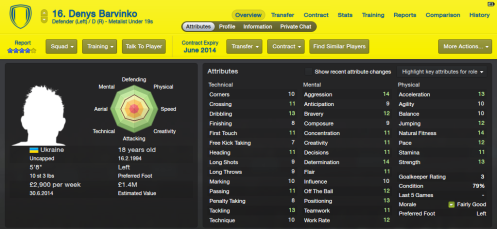


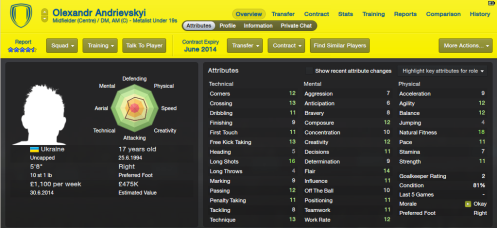


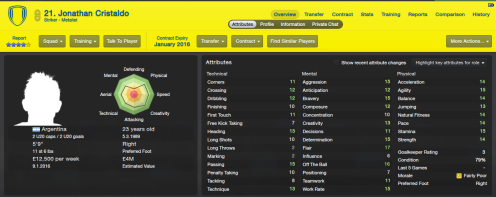

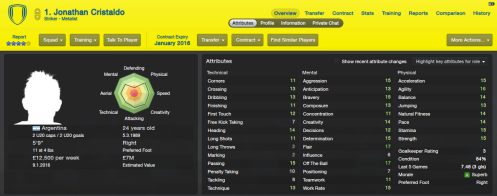
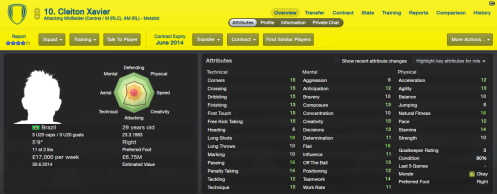

This is nice stuff. Far more granular than I usually bother to go with regard to personalities, but I’ve taken a lot of your observations on board and will now pay more attention when tutoring – thanks!
That is good to hear! However remember this isn’t the only approach. Consider tutoring as a means to an end. Playing time is by far the most important development tool we have.
In this save I am favouring professionalism because Metalist are a large club. In my Fradi save I prefer loyalty. This is because I can afford my young players playing time helping them develop. However once they become good and larger clubs try to buy them I am hopeful a loyal personality will help me reject bids without lowering morale.
Personality is a useful tool that can be adapted to our current needs.
Ditto. I had no idea how much influence the personalities had.
After re-reading my article I notice I leave an ambiguous question. That question is surrounding my argument of the role determination plays.
Professionalism and ambition are defined as of the field attributes. In the article I portray a professional player as a player who will train hard and someone who is more understanding of your decisions. I describe an ambitious player as a player who will do anything to get ahead. Whether that be through hard training or soliciting moves to larger clubs.
These two attributes clearly impact training levels.
Determination is defined by the game as an on field attribute (hence its visibility). If it is an on field attribute how does it have any bearing on training? My argument is morale. It has been noted (although not proven) that a happy player will train better. I suggest that a determined players morale will be less affected by team performance thus continue to train at a higher level in the event of poor team performance.
However it has been suggested to me (a point of which I agree) that a striker who scores a goal during a loss, will also retain morale. Therefore determination has no more bearing than a high finish attribute. I will point out though that the striker needs to therefore score. High finishing does not guarantee this outcome. High determination however will guarantee that during a poor performance said player will continue to work hard to produce a desirable result improving the chance this player will still perform well when others around him are not.
This explains my concession that determination plays a very minimal role in attribute increase. Due to a minimal link between this attribute and training level
54 points for Andreivskyi is mental. Does that include personality attribute points?
A good article with some interesting examples although I will admit to being slightly disappointed. Let me explain why. I think you had previously alluded to an approach whereby you tutored a player to improve his personality at an early age (let’s say 18) – improving ambition and professionalism so that his CA has the maximum opportunity of meeting his PA.
I then thought that you had a plan to tutor the player at 22 to then introduce alternative personality attributes – pressure, for example – even to the detriment of ambition and professionalism in the understanding that the majority of progression has been completed by 23.
I was looking forward to finding out a little more about that and whether it had worked. Nevertheless, a good article.
Oh, and thanks for the shout out!
Andrie’s 54 points are all in the attributes you can see. As I don’t use tools I have no idea how much his personality attributes have increased. So all in all a good year for him.
He seems to have stagnated slightly to date, i am hopeful though that this is a minor blip.
I apologies for your disappointment, however this approach is something I will be exploring throughout this save. At point of writing I did not have any suitable examples, so decided to leave it out and update in future posts